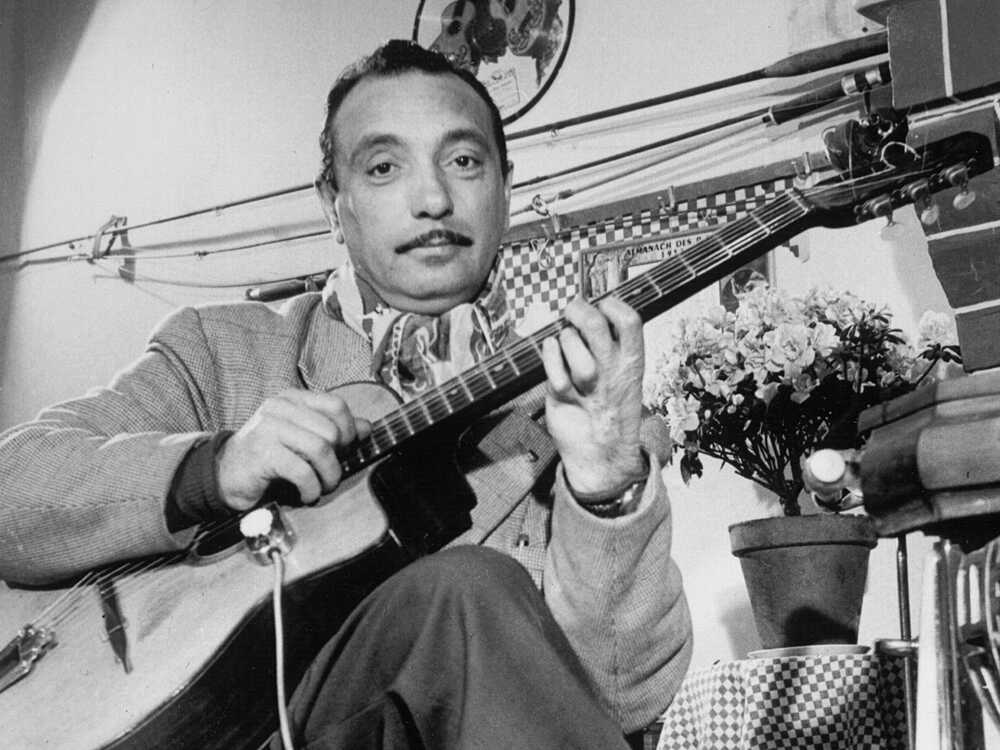Django Reinhardt – A Complete Biography
Introduction
Django Reinhardt (born Jean Reinhardt, January 23, 1910 – May 16, 1953) was a Belgian-born, Romani-French guitarist and composer who became one of jazz’s first great European innovators. Co-leading the Quintette du Hot Club de France with violinist Stéphane Grappelli, he helped make the guitar a lead instrument in jazz and created a virtuosic, lyrical language—despite losing the use of two fingers on his fretting hand after a devastating 1928 fire. Today his tunes (“Minor Swing,” “Nuages,” “Djangology,” among many others) are standards, and the idiom often called “gypsy jazz” or jazz manouche endures worldwide.

Childhood
Reinhardt was born in Liberchies, Belgium, to Manouche (Roma) parents and spent much of his early life traveling between Belgium and France. He grew up in encampments on the edges of Paris, learned violin and banjo-guitar as a child, and was performing professionally in his early teens. These formative years steeped him in the rhythms of bal musette and Romani song that would later flavor his jazz phrasing and sense of melody.
Youth
In his mid- to late-teens, Django was already a working musician in Paris dance halls and cafés, often on banjo-guitar. Then, in 1928, a life-altering accident occurred: a caravan fire seriously burned his left hand, leaving the ring and little fingers largely unusable. During a long convalescence he re-taught himself to play, building a singular technique that relied on the index and middle fingers for single-note runs and reserving the injured fingers mostly for chords. This tragedy forged the unmistakable sound of Django’s later jazz improvisations.
Adulthood
By 1934, having taken up the guitar in earnest, Reinhardt and Grappelli co-founded the Paris-based Quintette du Hot Club de France—one of the earliest all-string jazz groups, typically featuring two rhythm guitars, lead guitar, violin, and bass. The ensemble’s records from the mid-1930s are cornerstones of swing, celebrated for dazzling, guitar-and-violin front-line interplay and buoyant rhythm (“la pompe”).
When World War II began, Grappelli remained in Britain while Django stayed in occupied France, recording and performing with revised lineups (often adding clarinet). During these years, Reinhardt’s composition “Nuages” emerged as a signature piece; he recorded it multiple times, and it became one of his most beloved melodies.
After the war, Reinhardt briefly toured the United States in late 1946 as a featured soloist with Duke Ellington’s orchestra, appearing in New York and elsewhere. Contemporary photographs from this tour document Django’s arrival in America and his appearances with Ellington’s band.
In the early 1950s, back in France, Reinhardt experimented with amplified (electric) guitar and absorbed aspects of bebop into his fluid, harmonic style. He continued to compose and record, leaving a final cluster of sessions in 1953 that show his playing as agile and exploratory as ever.
Major Compositions
Reinhardt wrote or co-wrote dozens of pieces; many are now standards within jazz manouche and beyond. Highlights include:
- “Minor Swing” (1937) — co-written with Stéphane Grappelli; a quintessential gypsy-jazz vehicle built on driving minor-key changes.
- “Nuages” (1940–53) — perhaps his most enduring melody; recorded in multiple versions and widely covered.
- “Djangology,” “Daphné,” “Belleville,” “Swing 39/41/42/48,” “Douce Ambiance,” “Tears,” “Manoir de mes rêves (Django’s Castle),” “Anouman” — pieces that showcase his gift for memorable themes, harmonic color, and improvisational frames.
Death
On May 16, 1953, Django Reinhardt died at age 43 after a sudden brain hemorrhage. He collapsed at his home in Samois-sur-Seine and was taken to the hospital in nearby Fontainebleau, where he passed away—an untimely end for a musician whose influence has only grown since.
Conclusion
Django Reinhardt transformed the guitar’s role in jazz through sheer imagination, rhythmic drive, and melody-rich improvisation, all while overcoming a severe physical limitation. From the Quintette du Hot Club de France to his late electric experiments, his recordings remain a masterclass in swing feel and lyrical invention. His tunes are still played nightly by jazz musicians—evidence that Django’s voice, born of Romani roots and Parisian nights, has long outlived him.

Comments are closed